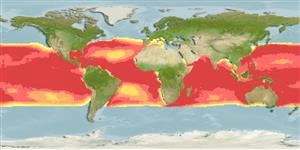Classification / Names
Common names from other countries
Main reference
Size / Weight / Age
Max length : 210 cm TL male/unsexed; (Ref. 9846); common length : 100.0 cm TL male/unsexed; (Ref. 3390); max. published weight: 40.0 kg (Ref. 30874); max. reported age: 4 years (Ref. 2885)
Length at first maturity
Lm 55.8, range 35 - 93.1 cm
Environment
Marine; brackish; pelagic-neritic; oceanodromous (Ref. 51243); depth range 0 - 85 m (Ref. 13608), usually 5 - 10 m (Ref. 40849)
Climate / Range
Subtropical; 21°C - 30°C (Ref. 26), preferred 28°C (Ref. 107945); 47°N - 38°S, 180°W - 180°E (Ref. 54341)
Distribution
Atlantic, Indian and Pacific: in tropical and subtropical waters. Highly migratory species, Annex I of the 1982 Convention on the Law of the Sea (Ref. 26139).
Countries | FAO areas | Ecosystems | Occurrences | Introductions
Short description
Dorsal
spines
(total): 0;
Dorsal
soft rays
(total): 58-66;
Anal
spines: 0;
Anal
soft rays: 25 - 31;
Vertebrae: 31. Greatest body depth in adults less than 25% of standard length; tooth patch on tongue small and oval; single dorsal fin extending from above eye almost to caudal fin with 58-66 rays; a concave anal fin extending from anus almost to caudal fin; pectoral fin more than half of head length (Ref. 10948). Caudal vertebrae usually 18 (Ref. 10998). Mature males posses a prominent bony crest in front of the head. The color is striking with golden hues on the sides, metallic blues and greens on the back and sides, with white and yellow on the underparts. Small specimens have pronounced vertical bars on the sides of the body.
IUCN Red List Status (Ref. 115185)
Threat to humans
Reports of ciguatera poisoning (Ref. 30911)
Human uses
Fisheries: highly commercial; aquaculture: commercial; gamefish: yes
Tools
Special reports
Download XML
Internet sources
Estimates of some properties based on models
Phylogenetic diversity index
PD50 = 1.0000 many relatives (e.g. carps) 0.5 - 2.0 few relatives (e.g. lungfishes)
Trophic Level
4.4 ±0.0 se; Based on diet studies.
Resilience
High, minimum population doubling time less than 15 months (K=0.4-1.2; tm<1; tmax=5; Fec=85,000)
Vulnerability
Moderate vulnerability (40 of 100)
Price category
